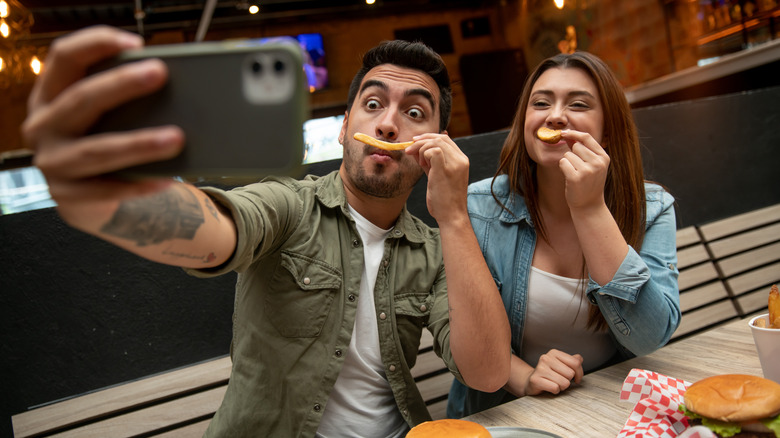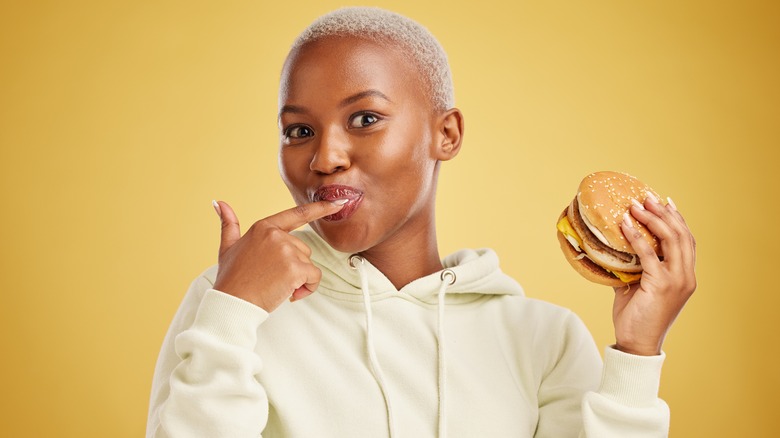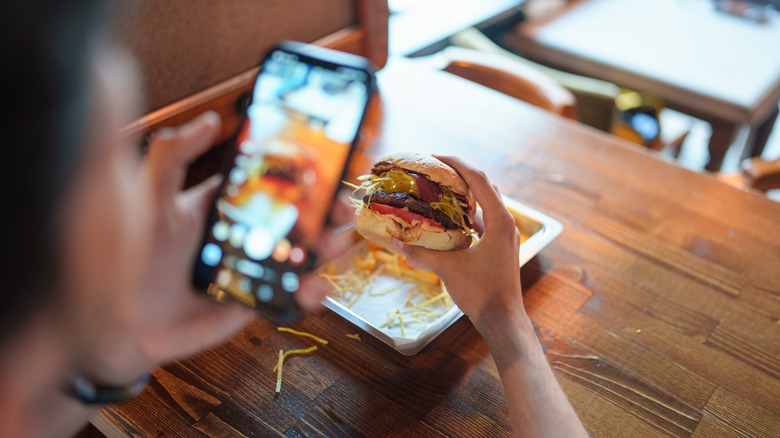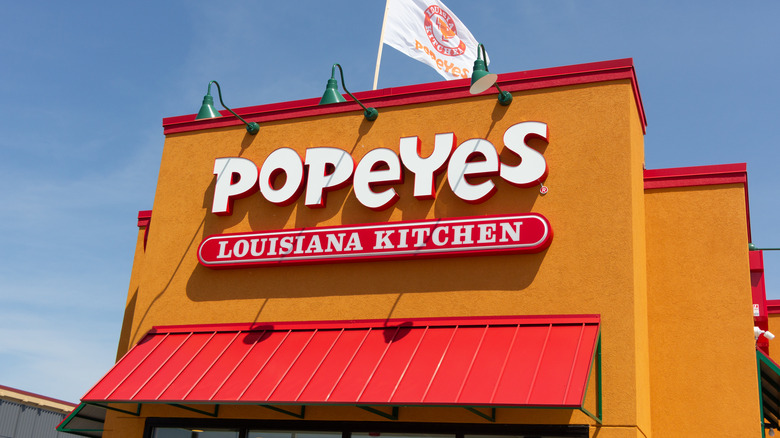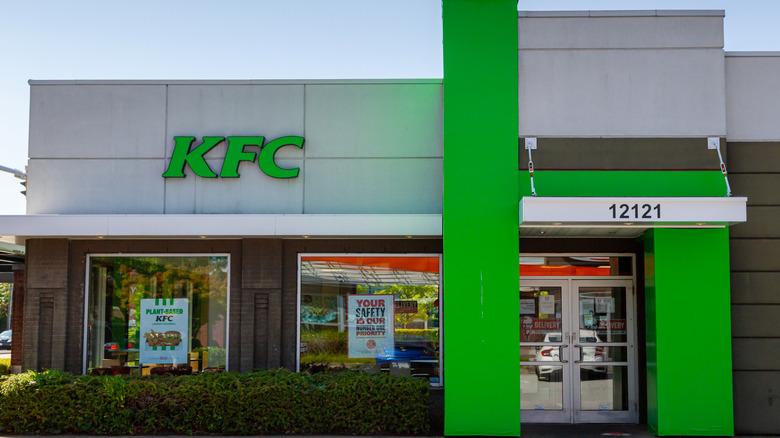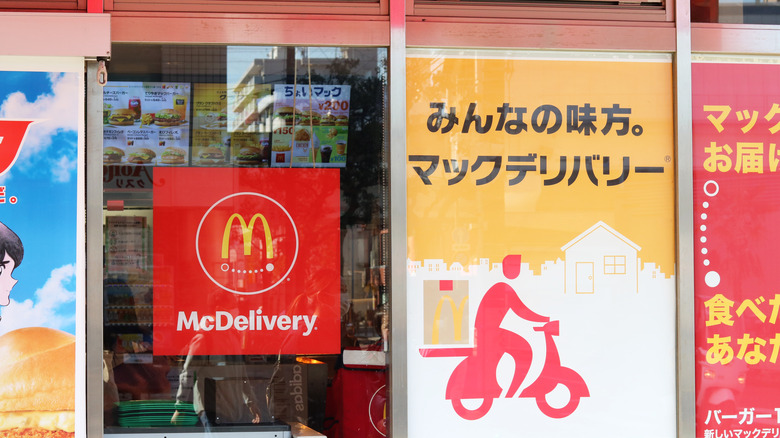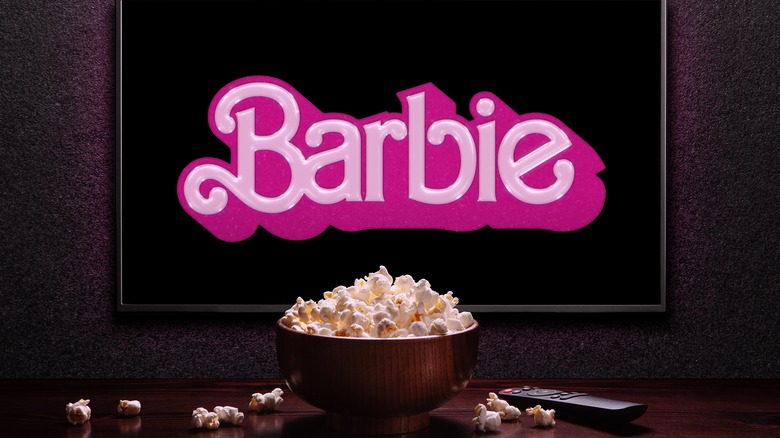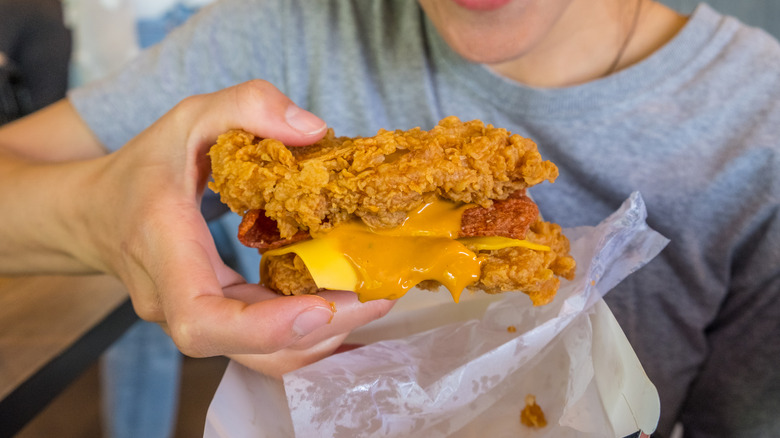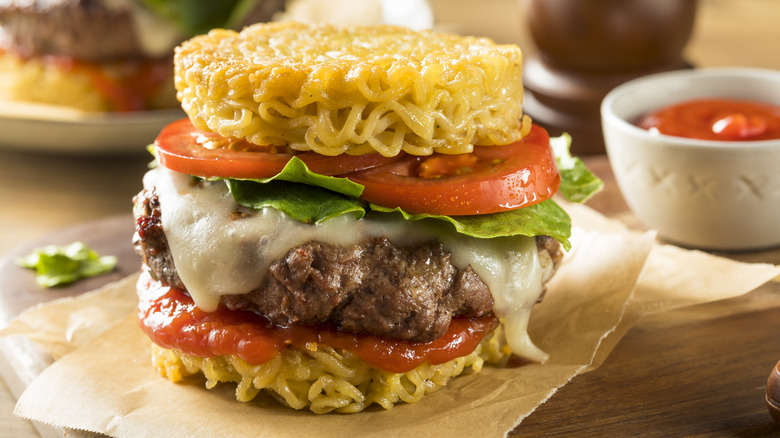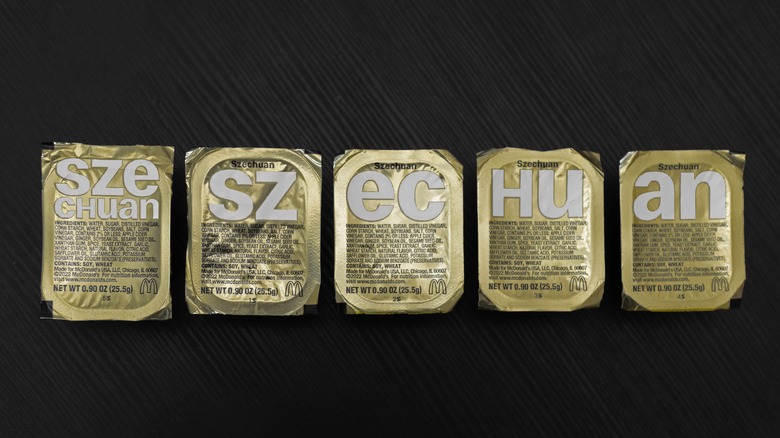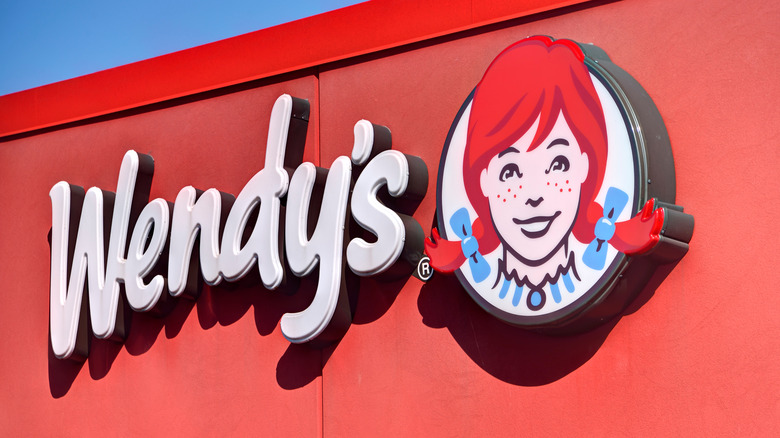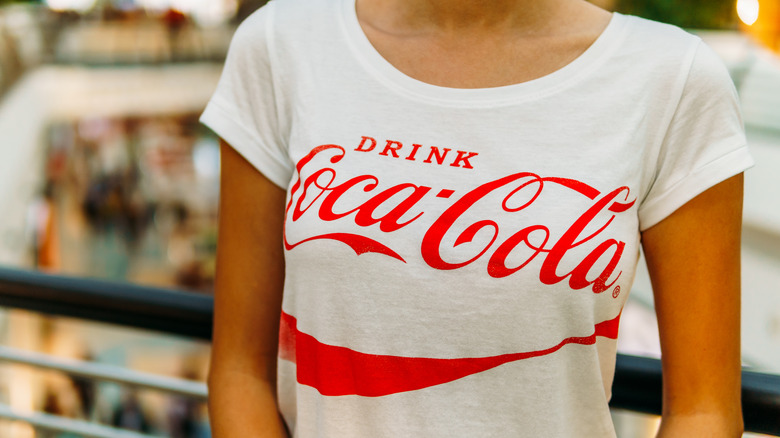Fast Food's Tricks For Anticipating The Next Trend
There you are, absentmindedly scrolling through your social media feed, and bam — your favorite fast food joint just dropped its latest creation: a dish that seems to be perfectly made for your current cravings, hyperfixation, and Insta feed. You wonder whether the chain tapped your phone or eavesdropped on your thoughts. You're left scratching your head, wondering, "How did the restaurant even think of that?" and more importantly, "Why do I suddenly need it?"
Fast food brands often bring back certain menu items from your childhood or collaborate with your favorite pop icons. They use a technique called trendspotting. It's not magic — though it often feels like it — but merely a calculated system of research and creativity that allows the restaurant chains to spot emerging patterns before they gain traction in the market. And they do this in a myriad of ways.
In this list, we reveal some of the nifty tricks, innovative strategies, and even some cloak-and-dagger tactics these brands deploy to stay ahead of our ever-evolving tastes. From simply reading your tweets to coming up with the weirdest food trends in history, these brands have their eyes set on what we want — even before we know that we want it ourselves.
Fast food chains dive deep into the minds of consumers
If you've wondered how these chains so accurately tap into our desires for cheap yet tasty meals, the simple answer lies in their comprehensive market research. By tuning into the nuances of consumer preferences, these chains not only dodge potential menu flops but also skillfully anticipate the next food trend.
For these companies, the goal is simple: Know where the food market is shifting, adapt promptly, and serve up the next big thing. This means they're not just jumping on food trend bandwagons — they're helping to create them. Take Apple co-founder Steve Jobs, for example, who told his biographer, Walter Isaacson, that he believed his job was about understanding consumers' wants, to "figure out what they're going to want before they do" (via Business Insider).
One example is Taco Bell's Doritos Locos Tacos, which recognized that consumers longed for food that catered to both their love for quick, convenient meals and the guilty pleasure of junk food. Sure enough, it was a safe, and very successful bet, with company executives calling it at the time the most successful product launch in Taco Bell history.
Marketing departments stalk social media (in a good way)
Most of us have, at some point, Instagrammed our milkshake or tweeted about how those McDonald's fries are hitting the spot at 3 a.m. Little did we know that the fast food industry has its eyes on every viral food challenge that often emerges on platforms like TikTok, Instagram, or X, formerly known as Twitter.
It's not just about counting likes or retweets. Brands dig deeper, deciphering every emoji, hashtag, and comment. They measure volume (how often a topic gets a shoutout) and gauge sentiment (are we lovin' it or not?). Take McDonald's all-day breakfast menu. The experts scoured through Twitter, identifying a whopping 334,000 tweets from the past, all craving for breakfast round the clock. Once the chain announced its all-day breakfast, it got a boost in stocks and a 10% rise in positive sentiments from breakfast-loving customers, according to a marketing analysis from Twitter, now known as X.
By keenly observing social media, brands also pick out stars that resonate with us to promote their new offerings. Remember Dunkin's choice of Ice Spice as the face for the viral Ice Spice Munchkins Drink? It was not an arbitrary choice at all — the chain knows how much buzz Ice Spice creates on social media.
Fast food brands capitalize on customer-generated marketing
We all have friends (or we are the friend) who snap a quick pic of that mouthwatering dish before digging in. But did you know that every snap, post, and tweet you share might be paving the way for the next trend? Brands actually encourage customers to share their experiences online, and they take notice of certain elements appearing more frequently in selfies and stories. More than just a boost in brand visibility, this interaction gives businesses a sneak peek into which menu items are in and which are out among the people.
Remember when everyone was sharing their unique Coca-Cola bottles and cans with names on them? Every time people shared their named product online, it was an unspoken endorsement, a nudge saying, "Hey, you should get one, too." And as more people bought their personalized bottles or cans and shared their experience, this seemingly simple campaign transformed into a massive trend.
Now, speaking of names, ever wonder why Starbucks spells your name wrong? It could be an innocent mistake, or perhaps, a brilliant marketing move. Every chuckle, eye-roll, and shared post about a misspelled name is immediate engagement, giving Starbucks exposure without it having to shell out a dime for advertising.
Restaurants ask customers for feedback
When it comes to predicting or even kickstarting trends, there's one simple trick that's also the most reliable: fast food chains just ask. From physical comment cards placed discreetly on tables and digital pop-ups on handheld point-of-sale systems to survey links at the bottom of your receipt, brands want to create a robust database from customer feedback so they can tweak or introduce items that meet current customer expectations and demands.
Sometimes, they even give the power to create the next menu item — and hopefully the next trend directly to us. In 2014, McDonald's introduced crowdsourced burgers across its menus in the United Kingdom, a competition that gave people the opportunity to give feedback on what they loved to put on their burgers and then to design their own dream burger. With a mind-boggling 98,000 entries, the public voted on the top 11, and the rest is history. Another example is KFC's Innovations Lab, which sought the next KFC-inspired phenomenon by allowing customers to propose and then crowd-fund ideas like a Kentucky Fried Hot Tub and a "Colonel on Ice" show. Here, the feedback question wasn't just a simple "What do you think of this?" instead, it asked, "What would you want next?"
Let's just say McDonald's and KFC were smart to turn feedback into an opportunity for product development. Who knew your two cents could be so valuable?
Strategists watch competitors closely
In the fast-paced world of burgers, shakes, and everything crispy, fast food brands are always trying to one-up each other, and that includes jumping on any trend that their competitor started.
Just take, for example, the legendary chicken sandwich showdown of 2019. When Popeyes launched its signature chicken sandwich that year, it practically broke the internet, and in just two weeks, it became such a sensation that it was nearly impossible to find one at a restaurant. Soon there were copycat recipes on YouTube and a rise in marketing promos from competing brands like the renowned Chick-fil-A, leading to what can only be described as an epic Twitter showdown when Chick-fil-A tweeted "Bun + Chicken + Pickles = all the (heart emoji) for the original." Popeyes responded in an epic way, simply tweeting: "... y'all good?" and garnered more than 275,000 likes. Wendy's then jumped into the conversation with a tweet saying, "Y'all out here fighting about which of these fools has the second best chicken sandwich."
Menu developers look to health and dietary trends
Fast food has long had the infamous reputation of being the poster child for everything unhealthy. But as younger generations like millennials and Gen Z bring with them a growing awareness of health, environment, and a conscious lifestyle, fast food brands have been capitalizing on these trends as well.
But how is looking at health trends the key to foreseeing the next big thing in fast food? Simple. By tuning into the changing lifestyles, beliefs, and dietary choices of their consumers, fast food brands ensure they're not just relevant but also pioneers in whatever food revolution comes next. KFC is a prime example. When it launched Beyond Meat's plant-based chicken, it wasn't just about catering to vegetarians or reducing meat intake. KFC's U.S. president, Kevin Hochman, told CNBC, "This is really about where the customer is going." The chain sees more vegetarians, so it creates a plant-based protein option. Then the trend for similar offerings across many food joints starts from there.
Turns out, there's more to anticipating the next trend than just introducing a new flavor or food — there's a need to understand the deeper shifts in society, culture, and individual identities. And right now, leveraging on that plant-based meat craze is where the real money's at.
Global franchises draw inspiration from international markets
Imagine the vibrant streets of Paris, where croissants are not just a breakfast staple, but also a cultural icon. Now, imagine Taco Bell looking at this revered pastry and thinking, "We can do something like that." And voilà, the Croissant Taco emerges in the U.S., setting the stage for the next fast food sensation. This is how global fast food franchises know just how to spot trendy food from one side of the globe and make it accessible on the other.
From the Stroopwafel McFlurry from McDonald's, which was Netherlands's delightful caramel-filled waffle cookie transformed into a McFlurry, to Dunkin's matcha lattes, which were only introduced to U.S. menus after the chain recognized the growing global trend for this traditional Japanese tea flavor — trends are like waves; they start somewhere, gain momentum, and then crash onto different shores. And while not all global hits become local favorites, these offerings, when done right, can bring a novel and trendy offering to a new set of consumers and maybe even set off a new food fad.
Promotion teams collaborate with pop culture trends
In today's social media-centric society, digital marketing that is infused with pop culture vibes has become the golden ticket for brands to win consumers' attention. By tapping into what's hot and happening in the entertainment world, these brands are not just selling food; they're making sure they're a part of the culture, too.
A survey by Magna and IPG Media Lab showed that brands that actively engage with cultural movements have a better shot at drawing in customers. In fact, about a quarter of consumers lean toward purchasing decisions influenced by a brand's cultural participation, according to the study. And when businesses do partake in pop culture, they see a boost in not just sales, but also in brand visibility and relevancy.
For example, when Greta Gerwig's "Barbie" movie came out, Barbie movie-themed foods became all the craze. Fast food restaurants such as Burger King Brazil whipped up a BK Barbie Combo, which included a burger with pink sauce, while over at Krispy Kreme Philippines, locations rolled out decadent Barbie Doughnuts accompanied by a Cotton Candy Chiller. Another example is when Burger King came up with the "Upside-Down Whopper" in a genius collaboration with Netflix's "Stranger Things." With pop culture collaborations like these, we get to enjoy our favorite pop phenomena in more ways than one, and fast food brands can anticipate the next trend by staying connected with the ever-evolving pop culture landscape. Total win-win.
Marketing teams keep watch on what's quirky, wacky, or bizarre
Ever been mind-boggled by a fast food item that made you go, "That's ... interesting"? From KFC's Double Down, a daring sandwich that boldly replaces its bun with fried chicken fillets, to Burger King's Mac 'N' Cheetos, a devilishly delicious combo of, well, macaroni and cheese in a Cheetos crust (yup, the chain went there), bizarre menu offerings create one important marketing tactic: buzz.
In an age where online chatter can catapult an item into stardom, fast food chains need to do more than just quench hunger; they must ignite curiosity. Thus, brands strategically deploy the bizarre to generate conversations and, in turn, demand. From Burger King's Bacon Sundae to Taco Bell's Cap n' Crunch Delights, these bizarre fast food items are carefully crafted to make a splash, to be audacious, and more importantly, to be something you'd want to gab about with friends or even showcase on your social media feed. So yes, if you find yourself scratching your head about a weird menu item that you just had to tell your friends, family members, and coworkers about — it means the marketing tactic is working, and you're just fanning the flames for a new trend that's to come.
Brands spice things up with new flavor combos
Remember the time when pizza was just ... pizza? Or when a donut was simply a ring of deep-fried goodness? These days, brands are creating snack fusions, like Pizza Hut's Cheez-It-shaped calzone, complete with the signature Cheez-It cheddar flavor, or KFC's fried chicken sandwich stuffed with the cheesy goodness of Cheetos. And over in the Philippines, Taco Bell rolled out a Cheetos Quesadilla, perfectly blending the cheesy crisps with its traditional Tex-Mex flavors. From cronuts and chocolate pizzas to ramen burgers and waffle tacos, brands are offering such mashups left and right — but why?
The answer is simple: By blending the strengths of two beloved items, brands can tap into multiple trends at once. Not only does this result in a product that delights (or disgusts) fans of both originals, but it also creates an entirely new flavor profile. And be real for a sec: What sounds trendier? A ramen and a burger separately, or a burger with fried ramen instead of buns?
Branding experts leverage nostalgia marketing
You know that warm, fuzzy feeling you get when you stumble upon an old photo album or find a cherished childhood toy? Well, fast food brands have mastered the art of evoking those very emotions, and they're doing it with a strategy known as nostalgia marketing.
One of the tactics involves reviving beloved items or themes from the past. For example, McDonald's introduced a Szechuan sauce in 1998 as part of a promotional tie-in with the Disney movie "Mulan." When the promotion ended, so did the sauce. But in 2017, fans of the "Rick and Morty" animated show clamored for McDonald's to bring its Szechuan sauce back after an episode titled "The Rickshank Rickdemption" included the main character's desire for the discontinued sauce.
McDonald's responded by re-introducing the sauce, capitalizing on the nostalgia-driven fervor created by the show's cult following. It's a prime example of how a fast food chain seized upon a pop culture trend to stay ahead of the game. McDonald's demonstrated an uncanny ability to spot a potential trend, make that demand available, and harness that trend to boost visibility and sales. Pretty clever.
Research departments set up culinary labs in disguise
In the quest to stay ahead of our ever-changing palates, did you know that fast food giants set up experimental outlets to test drive new, bold flavors to see if they catch and to learn when they're ready to be served to the nation? Ohio, in particular, seems to have a legendary reputation as the fast food industry's favorite guinea pig.
You know how Wendy's burger patties are square? Well, the folks in Columbus, Ohio, were the first lucky testers with the chain's first restaurant opening there. Or how about when Arby's decided that roast beef wasn't just for Sunday dinners but perfect for a quick grab-and-go in the form of a roast beef sandwich? It was the residents of Boardman, a suburb of Youngstown, Ohio, who first saw this fast-food sensation. And before Taco Bell decided to put the Doritos Locos Taco out to the world, it trialed the dish in Toledo back in 2011. The reason why Ohio often gets the first bite, literally, is because of its population mirroring much of the rest of the country and its central location.
By setting up culinary labs, these establishments can glean real-time insights into consumer preferences, allowing them to refine and ultimately predict which products have the potential to become the next "it" food and subsequently, the next big trend.
Promotion teams create buzz through fashion collaborations
Fast food and fashion might seem like an unlikely pair, but they both are reflections of current events and shifts in society's preferences — and though it may seem unconventional, announcing collabs with name brands both in the world of dining and high fashion is actually a pretty good way to gauge where cultural trends are headed.
For example, when Zara and Coca-Cola collaborated in 2021 to pay homage to Coca-Cola's vintage items from the 1980s, such as Coke-themed sweatshirts, it could signify a rising trend of nostalgia or retro themes — meaning fast food brands should think about reviving old menu items or introducing retro-themed dishes. Another example is when streetwear brand Anti Social Social Club collaborated with Panda Express. The success of this partnership could translate into exploring menu options that tap into popular urban subcultures appealing to a younger, more cosmopolitan audience.
Whether it's a rising preference for sustainability or a renewed love for retro, the popularity of a particular collaboration can offer insights into what resonates with audiences, ultimately influencing menu innovations, marketing strategies, and branding directions.
Marketing teams craft holiday-inspired innovations
Fast food brands have long recognized the allure of seasonal offerings. Tying their products to holidays or significant events not only capitalizes on the general festive mood but also triggers a sense of recency and relevancy. The result? A brief yet intense burst of sales driven by consumers yearning for that special taste of the season.
Take, for instance, the pumpkin spice phenomenon. What started as a humble autumnal flavor exploded into a full-blown cultural trend. Brands noticed, and now as fall approaches, a deluge of pumpkin-spiced goodies, from lattes to pies, litter the market. In December, there is demand for festive tastes: a hint of cinnamon, the rich scent of roasted chestnuts, and a dash of peppermint. And then there's the summer, which is all about frozen beverages or ice cream treats.
Because these seasonal offerings are so timely, fast food brands create a buzz that's nearly impossible to not engage in. If scarves, snow globes, and Santa are in stock — undoubtedly you'll find the peppermint drinks and pecan pies nearby.
